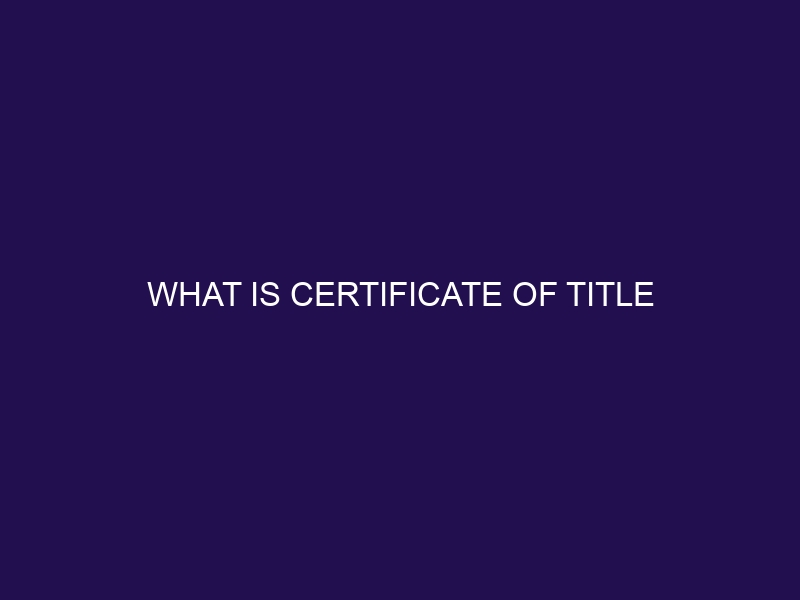What is Certificate of Title
A Certificate of
One of the primary functions of a Certificate of
Obtaining a Certificate of
A Certificate of
To ensure the authenticity of a Certificate of
Common issues with Certificates of
Transferring a Certificate of
What is a Certificate of Title?
A certificate of title is an official document that proves ownership of a property or vehicle. It provides information about the current owner, any liens or encumbrances on the property or vehicle, and the legal description of the property. The certificate of title serves as a crucial legal document in real estate transactions and can also be used as collateral for loans. Understanding what a certificate of title is and the information it contains is essential when buying or selling property or vehicles.
What is a Certificate of Title? It is an official document that proves ownership of a property or vehicle. It provides crucial information about the current owner, any liens or encumbrances on the property or vehicle, and the legal description of the property. When buying or selling property or vehicles, it is essential to understand the significance of a certificate of title and the information it contains. Additionally, it can be utilized as collateral for loans in real estate transactions.
Why is a Certificate of Title Important?
Why is a Certificate of
A certificate of title is crucial when it comes to real estate transactions. It serves as legal proof of ownership and provides information about any claims or liens on the property. Having a certificate of title is important because it ensures a smooth transfer of ownership, protects the buyer from potential legal issues, and helps establish the property‘s value. It allows for proper documentation and record-keeping, which is essential for future reference or resale purposes. Therefore, understanding the significance of a certificate of title is vital when engaging in any property transaction.
What Does a Certificate of Title Show?
A certificate of title showcases vital information about a property, encompassing details of ownership, property boundaries, and any encumbrances or liens. It serves as an official document that provides undeniable evidence of ownership and legal rights to a property. This documentation comprises particulars about the current owner, past transactions, and any limitations or easements that could potentially impact the property. Additionally, it includes the legal description, tax specifics, and any existing leases or mortgages associated with the property. An examination of the certificate of title allows for a comprehensive understanding of the property’s history and identifies any potential legal complications linked to it.
As an authentic historical example, a certificate of title could reveal the lineage of ownership for a historic family home, tracing the transfer of the property from one generation to the succeeding one.
What Legal Rights Does a Certificate of Title Provide?
A certificate of title provides legal rights and protections for property owners. It serves as proof of ownership and establishes the rights and interests that an individual has in a property. The question of “What Legal Rights Does a Certificate of
| 1. Ownership Confirmation: | A certificate of title confirms that the individual named on the certificate is indeed the rightful owner of the property. This legal document safeguards their ownership rights. |
|---|---|
| 2. Security against Unauthorized Claims: | By establishing a clear legal record of ownership, a certificate of title protects property owners against any unauthorized claims or disputes. It ensures that their ownership rights are recognized and respected. |
| 3. Transferability and Legal Protection: | The certificate of title allows property owners to sell, transfer, or mortgage the property. This flexibility is significant as it enables property owners to exercise their rights and make transactions with legal protection. Buyers and lenders are also safeguarded by the legal validity of the certificate of title. |
In summary, a certificate of title is crucial in establishing legal rights and protecting the interests of property owners. It allows individuals to have ownership confirmation, security against unauthorized claims, and the ability to undertake property transactions with legal protection.
How is a Certificate of Title Obtained?
To obtain a Certificate of
- Gather necessary documents, such as the original sale deed, encumbrance certificate, and the latest tax receipts, in order to apply for a Certificate of
- Pay a visit to the local land registration office and submit the application for a Certificate of
- An officer at the land registration office will carefully examine the provided documents and perform a thorough search to ensure that there are no pending disputes or claims on the property.
- If all the documents are deemed satisfactory, the officer will proceed to issue the Certificate of
- Finally, the Certificate of
- Pay a visit to the local land registration office and submit the application for a Certificate of
What Information is Included in a Certificate of Title?
A Certificate of is more than just a piece of paper – it holds valuable information about a property. In this section, we’ll uncover the hidden gems within a Certificate of . From property details to ownership information, and even encumbrances and liens, each sub-section uncovers a different layer of crucial insights that can impact your understanding of a property’s history and present state. Get ready to dive deep into this essential document that reveals the secrets of property ownership.
Property Details
When it comes to property details, a certificate of title provides crucial information for potential buyers and owners alike.
- Boundary lines: The certificate of title includes accurate measurements and locations of the property’s boundaries, ensuring clarity and preventing disputes.
- Parcel identification: It lists the unique identifiers such as lot and section numbers, allowing for easy identification and tracking of the property.
- Registered interests: Any registered interests on the property, such as mortgages, easements, or covenants, are noted in the certificate of title.
- Building restrictions: It outlines any building restrictions or planning requirements that must be adhered to when developing the property.
Understanding these property details is vital when considering purchasing or managing real estate.
Ownership Information
The ownership information included in a certificate of title provides crucial details about property ownership. It typically includes the name of the current owner, as well as any previous owners of the property. This information is important for establishing legal rights and responsibilities related to the property. Other details such as the date of ownership transfer and any encumbrances or liens on the property may also be included. Verifying the authenticity of the certificate of title is essential to ensure that the ownership information is accurate and valid. Common issues with certificates of title can include forgery or fraud, outdated information, and disputes or conflicting claims. Transferring a certificate of title involves processes such as selling or buying property or transferring ownership due to inheritance.
| Ownership Information |
|---|
| Name of Current Owner |
| Previous Owners |
| Date of Ownership Transfer |
| Encumbrances and Liens |
A true historical account of ownership information can be seen in the case of the Mona Lisa. The certificate of title for the famous painting reveals that it was originally owned by Leonardo da Vinci himself. Over the centuries, the ownership of the artwork changed hands multiple times, with prominent figures like King Francis I and Napoleon Bonaparte being recorded as previous owners. The certificate also highlights the transfer of ownership from the Louvre Museum to the French government, ensuring its protection and preservation for future generations to admire. This ownership information remains an integral part of the painting’s history and authentication.
Encumbrances and Liens
| Encumbrances and Liens | Encumbrances and Liens |
|
Important aspects to consider when dealing with a certificate of title for a property. These can have significant implications for the ownership and transfer of the property. It is essential to understand what encumbrances and liens are and how they can affect the title. |
Important aspects to consider when dealing with a certificate of title for a property. These can have significant implications for the ownership and transfer of the property. It is essential to understand what encumbrances and liens are and how they can affect the title. |
|
Existing mortgages or loans on the property. |
Claims or legal rights over the property to secure a debt. |
|
Easements or rights-of-way granted to others. |
Unpaid taxes or assessments on the property. |
|
Covenants or restrictions on the use of the property. |
Unresolved legal disputes or judgments related to the property. |
Properly analyzing and addressing encumbrances and liens is crucial in real estate transactions to ensure a clear title and avoid potential legal issues. It is advisable to consult with legal professionals and conduct a thorough title search to identify and resolve any encumbrances or liens before completing a property sale or transfer.
How to Verify the Authenticity of a Certificate of Title?
How to Verify the Authenticity of a Certificate of
- Check the document’s design and layout, ensuring it matches official templates.
- Verify the issuer’s credentials, including their reputation and authority to issue title certificates.
- Confirm the presence of security features like watermarks, holograms, or unique serial numbers.
- Research the document’s history, including previous owners and any outstanding liens or encumbrances.
- Compare the information on the certificate with official records, such as land registries or government databases.
What Are Some Common Issues with Certificates of Title?
Concerning the topic of “What Are Some Common Issues with Certificates of ?”, we will shed light on the potential pitfalls that surround this essential document. From forgery and fraud to inaccuracies or outdated information, as well as disputes and conflicting claims, we’ll explore the numerous challenges faced by individuals when dealing with certificates of title. Join us as we uncover the intricacies and potential complications that arise within this domain.
Forgery and Fraud
Forgery and fraud are prevalent issues associated with certificates of title. It is imperative to authenticate the certificate’s legitimacy to prevent becoming a victim of these criminal activities. The creation of counterfeit certificates, manipulation of existing ones, and the insertion of false data are some common forms of forgery and fraud. Engaging in such deceitful actions can have severe consequences, including the loss of property rights or financial harm. To safeguard yourself, it is vital to carefully scrutinize the certificate of title, validate the information with relevant authorities, and seek guidance from legal professionals if you suspect any fraudulent behavior.
Inaccurate or Outdated Information
Inaccurate or outdated information on a certificate of title can result in various issues and complications in property ownership. It is imperative to verify the accuracy of the information before relying on it. Some common problems include misspelled names, incorrect property details, or outdated ownership records. These inaccuracies can cause delays in property transactions and even lead to legal disputes. To avoid these problems, individuals should diligently review the certificate of title and cross-check the information with relevant authorities. It is also advisable to seek professional assistance from legal experts or title insurance companies to ensure the accuracy and validity of the certificate of title.
Disputes and Conflicting Claims
In the realm of property ownership, disputes and conflicting claims can arise regarding the validity or rights associated with a Certificate of
| Common Issues | Causes and Implications |
| Forgery and Fraud | False or fraudulent certificates can lead to disputes over ownership or the transfer of property. |
| Inaccurate or Outdated Information | Errors in the certificate can create confusion and disputes. Outdated information might fail to reflect recent transactions. |
| Disputes and Conflicting Claims | Conflicting claims arise when multiple parties assert ownership rights over the same property, resulting in legal disputes and potential litigation. |
How to Transfer a Certificate of Title?
Looking to transfer a certificate of title? In this section, we’ll dive into the process of transferring ownership and explore two key scenarios: selling or buying property and transferring ownership due to inheritance. Discover the ins and outs of these transactions as we navigate the legal steps and potential challenges involved. Get ready to navigate the world of certificates of title with confidence.
Selling or Buying Property
When it comes to selling or buying property, understanding the importance of a Certificate of
- Verification: Before purchasing property, always request a copy of the Certificate of
- Ownership: The Certificate of
- Encumbrances: It discloses any encumbrances, such as mortgages or liens, that may affect the property.
- The Certificate of
- Transfer process: When selling or buying property, the Certificate of
- Ownership: The Certificate of
Prioritize due diligence and consult legal professionals for a seamless selling or buying experience.
Transferring Ownership due to Inheritance
- Obtain a copy of the deceased person’s will or probate documents for the purpose of transferring ownership due to inheritance.
- Notify the relevant authorities, such as the Land Registry or local government, about the change in ownership resulting from inheritance.
- Complete the necessary application forms to transfer the Certificate of
- Provide supporting documentation, including death certificates, evidence of relationship to the deceased, and any legal requirements outlined in the will, to facilitate the transfer of ownership due to inheritance.
- Pay any applicable fees for the transfer process when transferring ownership due to inheritance.
- Wait for the application to be processed and the new Certificate of
- Update any relevant parties, such as insurance companies or mortgage lenders, about the change in ownership resulting from inheritance.
Following these steps will help ensure a smooth transfer of ownership due to inheritance.
Frequently Asked Questions
What is a certificate of title?
A certificate of title is an official document issued by the state that proves ownership of personal or real property. It is used for various types of property such as real estate, businesses, boats, and vehicles.
Are certificate of title and deed the same?
No, a certificate of title and a deed are not the same. While a certificate of title is an opinion document that proves ownership of property, a deed is a contract-like document that transfers the right of ownership from one party to another.
What information does a certificate of title contain?
A certificate of title contains identification information about the owner(s) of the property, such as name and address. It may also include information about any liens or outstanding loans on the property, as well as the status of the title.
What is the difference between a certificate of title and a vehicle registration?
A certificate of title is an official document that proves ownership of a vehicle, while a vehicle registration is a temporary or permanent registration of the vehicle with the Department of Motor Vehicles. The certificate of title identifies the owner(s) and any liens, while the vehicle registration provides information such as the license plate number and expiration date.
Is a certificate of title a guarantee of a clear title?
No, a certificate of title is not a guarantee of a clear title. There may be unrecorded encumbrances, liens, or fraudulent activity associated with the property. It is important to conduct a thorough title search before finalizing large transactions to ensure there are no issues with the title.
How long does it take to obtain a certificate of title?
The time it takes to obtain a certificate of title may vary. It typically involves conducting a title search and gathering necessary documentation. The process can take several weeks to complete depending on the jurisdiction and complexity of the transaction.







